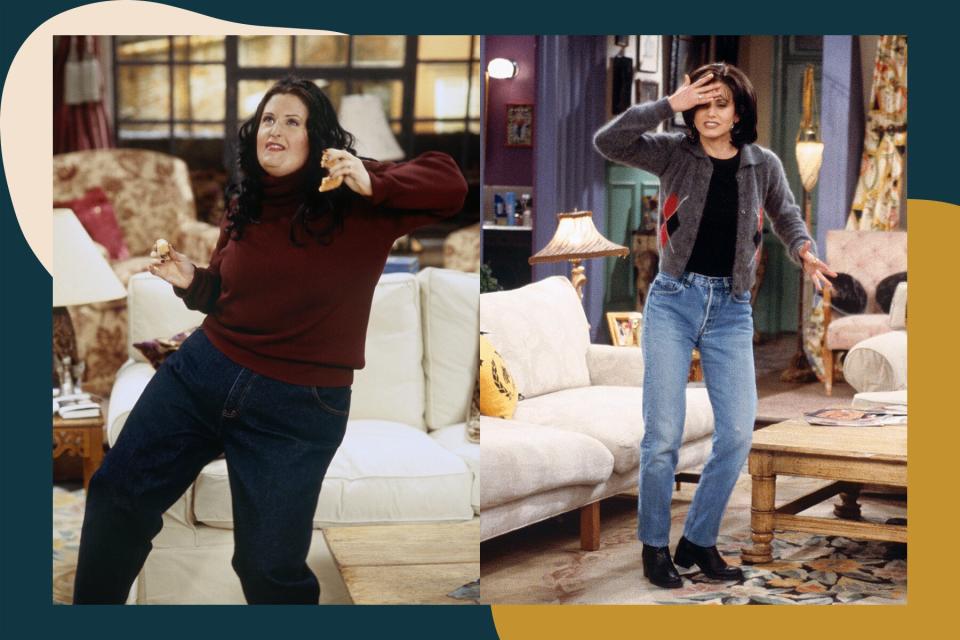What You Should Know Before Posting a Before/After Weight-Loss Photo

NBCUniversal, Getty Images
Approximately 68% of women in America are considered plus-size, but there’s a clear lack of industry representation and shopping options for this majority. In Plus-Size Diaries, columnist Olivia Muenter dives into all things plus-size, from sharing her personal experiences to speaking out about plus-size culture at large.
Buried deep in my phone, somewhere in the tens of thousands of photos I’ve taken over the years, are pictures that are somewhat unlike all the others. Even though I spend a good deal of my time documenting my favorite outfits, places, and meals via my Instagram, these particular photos weren’t taken to highlight a happy memory or celebrate anything at all. Instead, these photos were taken to measure myself—to have a benchmark to compare old me to future me. They were my "before" pictures, taken in the hopes that I could use them to track how much weight I had lost, just in case the scale was lying.
I would take these photos in specific pieces of clothing, usually items that were old or too-tight, and I would snap the images quickly, hardly looking at the final shots. I’d file them away in a secret folder on my phone and tell myself that even just taking the photos was progress. A couple of weeks later, I’d put on the same outfit and see if it felt or looked looser. I’d place the photos side by side in a collage, measuring progress, marking success or failure by the way a sleeve fit or a button closed.
At one point in my life, many years ago, I would post these photos for other people to see—sometimes on secret Tumblr accounts dedicated to encouraging weight loss.
I craved feedback, confirmation that whatever I was doing that month was working. Often, though, I would keep them just for me. After years of obsessive dieting and hating my body, I was embarrassed by the photos, after all—all of them taken to display the parts of myself I wanted to shrink the most. But I also felt like I needed them to hold myself accountable and stay motivated. They were a tool. Many years later, when I finally began to accept my toxic, disordered relationship with food, exercise, and my body, I became embarrassed of them for another reason. I was ashamed that I still wanted to keep them at all, even after letting go of dieting, starving myself, and obsessively counting calories. I was mortified that a large part of me was worried about what would happen if I got rid of them altogether.
As my relationship with my food and my body has continued to heal over the years, I’ve found it easier to delete these images and avoid taking them altogether.
However, I’ve still gone through months where I’ve started the process all over again, taking the photos, storing them away, taking the same photos in the same pose in a week, and so on. I don’t pair these photos with restrictive dieting or exercise as punishment now, but I know the habit still isn’t healthy. I know that worshipping a future, “thinner” me is inherently dangerous, not to mention a disservice to my current body and current self. Almost always, though, this cycle is triggered by seeing before-and-after photos of someone else on social media, by craving some sort of confirmation that I am not getting bigger.
Sometimes, admittedly, I will find myself seeking out the content, craving a reason to fall back into the cycle once again. More often, though, these photos pop up on my Instagram feed anyway—from friends or family or strangers or influencers. I recognize that weight loss is a personal choice and one that people make for a variety of reasons, many of which may have nothing to do with aesthetics at all.
However, before-and-after photos have everything to do with aesthetics, and there’s no getting around that.
The captions of these posts will often try to deflect from this and instead wax poetic about gaining strength or endurance or confidence, but the underlying message is the same: Thinner is better and happier. Smaller is better and happier. If that wasn’t the case, the “after” photo on its own would be enough. It’s the physical juxtaposition of a smaller body next to a bigger body that makes it matter, that makes it impactful, that makes it praise-worthy.
And the thing is: There have been many times in my life when I’ve considered posting these very same before-and-afters, times when I’ve starved myself for a couple of months and felt proud of the results. Times when I had convinced myself that my obsession with the photo montages was healthy. Times when I would have thought that someone else being affected by the set of images would be their problem and not mine.
Sometimes I still have all of these thoughts. But then I focus on a series of questions: Why do I need anyone else’s approval or praise about my body? Why do I need to compare myself to a bigger version to feel successful? Isn’t it so much more powerful not to need any of that at all to feel good in my body? And then I don’t post the photos, and I don’t think about them as much, either. And then I know that there’s one less before-and-after floating around in the universe, telling someone else that their body isn’t good enough as-is. And that feels better to me than any before-and-after ever felt.

 Yahoo Sports
Yahoo Sports 